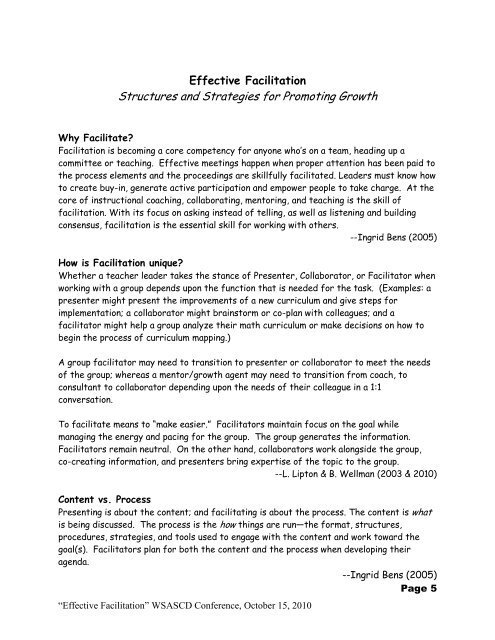3hPlSq
3hPlSq
3hPlSq
Create successful ePaper yourself
Turn your PDF publications into a flip-book with our unique Google optimized e-Paper software.
Effective Facilitation<br />
Structures and Strategies for Promoting Growth<br />
Why Facilitate?<br />
Facilitation is becoming a core competency for anyone who’s on a team, heading up a<br />
committee or teaching. Effective meetings happen when proper attention has been paid to<br />
the process elements and the proceedings are skillfully facilitated. Leaders must know how<br />
to create buy-in, generate active participation and empower people to take charge. At the<br />
core of instructional coaching, collaborating, mentoring, and teaching is the skill of<br />
facilitation. With its focus on asking instead of telling, as well as listening and building<br />
consensus, facilitation is the essential skill for working with others.<br />
--Ingrid Bens (2005)<br />
How is Facilitation unique?<br />
Whether a teacher leader takes the stance of Presenter, Collaborator, or Facilitator when<br />
working with a group depends upon the function that is needed for the task. (Examples: a<br />
presenter might present the improvements of a new curriculum and give steps for<br />
implementation; a collaborator might brainstorm or co-plan with colleagues; and a<br />
facilitator might help a group analyze their math curriculum or make decisions on how to<br />
begin the process of curriculum mapping.)<br />
A group facilitator may need to transition to presenter or collaborator to meet the needs<br />
of the group; whereas a mentor/growth agent may need to transition from coach, to<br />
consultant to collaborator depending upon the needs of their colleague in a 1:1<br />
conversation.<br />
To facilitate means to ―make easier.‖ Facilitators maintain focus on the goal while<br />
managing the energy and pacing for the group. The group generates the information.<br />
Facilitators remain neutral. On the other hand, collaborators work alongside the group,<br />
co-creating information, and presenters bring expertise of the topic to the group.<br />
--L. Lipton & B. Wellman (2003 & 2010)<br />
Content vs. Process<br />
Presenting is about the content; and facilitating is about the process. The content is what<br />
is being discussed. The process is the how things are run—the format, structures,<br />
procedures, strategies, and tools used to engage with the content and work toward the<br />
goal(s). Facilitators plan for both the content and the process when developing their<br />
agenda.<br />
--Ingrid Bens (2005)<br />
Page 5<br />
“Effective Facilitation” WSASCD Conference, October 15, 2010


